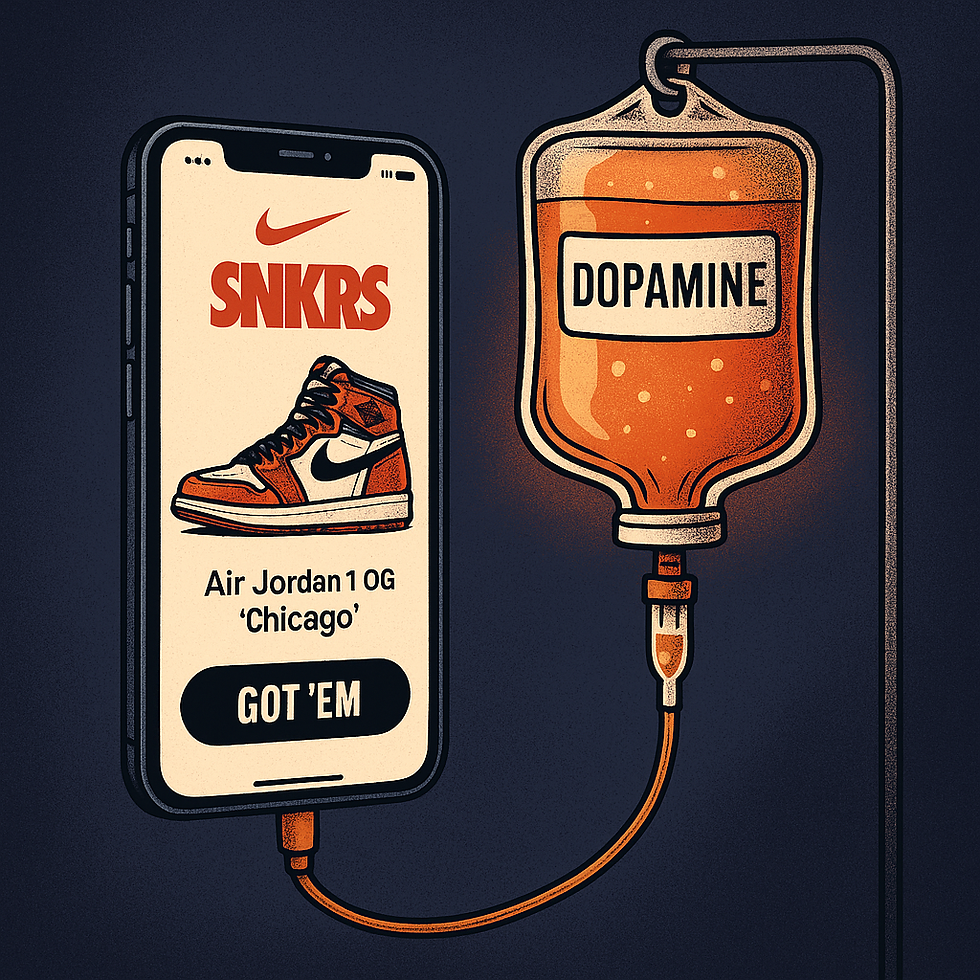The Dopamine Drop: What Buying Sneakers Does to the Brain (And Why It Can Be Addictive)
- SAFEHAUS

- May 16
- 3 min read

Beyond the Hype: The Brain Chemistry of a Cop
When you go after a sneaker drop—whether it’s a SNKRS exclusive, raffle, or shock release—you’re not just engaging in a cultural ritual. You’re activating specific parts of your brain: particularly the mesolimbic dopamine pathway, the same system involved in risk-taking, romantic attraction, and even drug use.
Dopamine is often misunderstood as the “pleasure chemical.” In reality, it’s more about anticipation and motivation. In sneaker culture, the build-up to a drop is what causes dopamine to surge—not necessarily the moment of unboxing. That rush? It’s chemically identical to chasing a slot machine win.
The Psychology of Scarcity and Intermittent Reinforcement
Behavioral psychologists have long studied what’s called intermittent reinforcement schedules—rewards that are unpredictable and inconsistent.
Think of slot machines or loot boxes in video games.
Sneaker brands mimic this model with:
Randomized exclusive access
Bot-dominated FCFS releases
High heat/low supply ratios
This keeps users hooked because the brain becomes trained to crave the possibility of winning, even if the outcome is rare. Over time, this produces a feedback loop that mirrors behaviors seen in compulsive gambling.
Why the Chase Is Stronger Than the Catch
Once a sneaker is secured, dopamine levels often drop. This is called "anticipatory reward bias"—our brains are wired to overvalue the chase. It's why many sneakerheads report feeling more excitement before the cop than after.
This explains a key contradiction in the culture: people may buy sneakers they don’t truly love, simply because they were “hard to get.” The difficulty of access becomes a proxy for value—both psychological and social.
Data-Driven Dopamine: How Brands Engineer Addictiveness
Major sneaker brands and tech platforms now rely on behavioral analytics and neuro-marketing to deepen engagement.
Apps like SNKRS and Confirmed track:
How long users hover on a product
Drop timing to match user dopamine peaks (often late morning or mid-week)
Micro-interactions (likes, shares, taps) that reinforce perceived scarcity and exclusivity
Some even A/B test push notification language to maximize open rates and engagement, subtly manipulating emotional response through language-based dopamine triggers.
Social Dopamine: The Role of Community Validation
It’s not just the shoe—it’s the clout. Social media metrics (likes, comments, reposts) stimulate the striatum, another brain region involved in social reward and status hierarchy.
Platforms like Instagram, TikTok, and Discord act as amplifiers. When a user posts a successful cop or an on-foot shot, the response loops back into their dopamine system—validating the behavior and encouraging repetition. This builds what cognitive psychologists call "habitual identity reinforcement."
In short: copping becomes part of who you are, not just what you buy.
Neuromarketing Meets Hype Culture: The 2025 Reality
In 2025, the most successful sneaker brands aren’t just designing products—they’re designing experiences that trigger brain chemistry.
Some of these strategies include:
Progressive engagement via app-based tiers (gamified loyalty)
Augmented reality drops to heighten novelty
"Drop fatigue" pacing to prevent dopamine burnout (yes, even that’s planned)
We're now in an era where neuroscience is embedded into product strategy—where buying is less about utility and more about neural manipulation.
Is There a Way to Opt Out Without Missing Out?
Sneaker culture doesn't have to be predatory. Awareness is key. Platforms like SafeHaus exist to provide community-based discovery that sidesteps the dopamine traps.
Being intentional—following your own taste, building authentic rotation, resisting clout-fueled decisions—can retrain your reward systems over time.
Neuroplasticity isn’t just a buzzword; your brain can adapt. But you have to disrupt the loop.
Final Thought: The Brain Behind the Drop
What sneaker culture has built—often accidentally, sometimes strategically—is a modern reward economy. At its heart is not just footwear, but neurological programming: anticipation, loss aversion, risk, identity, and validation.
Understanding how the system works doesn’t take the fun out of it. If anything, it gives you control.
Because in a world where your attention, motivation, and habits are the product, your awareness is the rarest flex of all. Continue to visit SafeHaus for more insightful topics like this one!



Comments